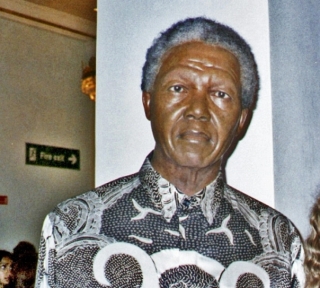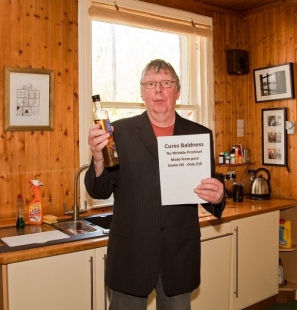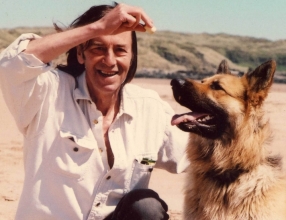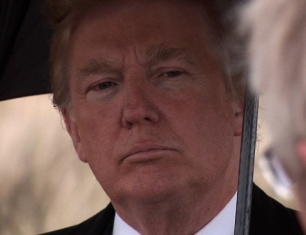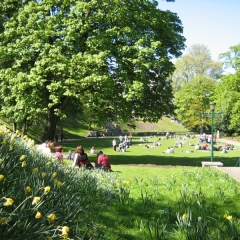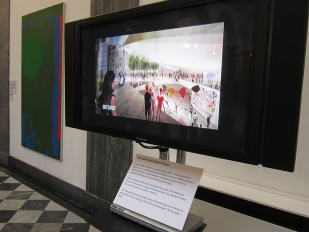Having previously looked at the people who can be considered heroes for their attempts to protect the environment or people, the focus shifts to the ‘villains’ in this fifth article in the Menie Estate Series.
By
Suzanne Kelly.
Identifying the players in the course of events at Menie is key to understand what happened, and hopefully to preventing a repeat performance elsewhere.
The cumulative effect of the various pro-Trump factions, large and small, all helped make the development’s approval all but inevitable.
This article will take stock of the people, organisations and incidents that won the day for golf over natural heritage, existing planning policy and area residents.
Donald Trump
Ultimate responsibility for the loss of the SSSI and for the use of security firms in the area surely belongs to the man called ‘The Donald.’ While involved in litigation in his home country, the USA, with private individuals and local governments, our powers-that-be still accepted his fiscal health, his stated commitment to the environment, and his economic proposals at face value.
To illustrate, here are excerpts from one of the Scottish Government’s statements supporting the development:-
“The council understand the suggestion made by the various parties that a personal condition may be appropriate… that is not proposed… Based on the evidence the council believes that the commitment shown by Mr Trump is genuine.” – http://www.scotland.gov.uk/Resource/Doc/212607/0067709.pdf
Aberdeenshire Council decided that their ‘belief’ in Trump’s commitment was genuine and of more importance than existing planning guidance and the SSSI. This faith seems to have been built on the economic case presented by Trump (later criticised sharply by a London School of Economics expert, who featured in the documentary ‘You’ve Been Trumped’).
This faith also seems to have excluded any research into the Trump Organisation’s past form and apparent predilection for suing municipalities (for a summary of some rather worrying past Trump actions.
See donald-trumps-lawsuits-could-turn-conservatives-who-embrace-tort-reform
Scottish Natural Heritage suggested it would be possible to build great golf courses and housing without using the sensitive SSSI sites; however, Trump refused to compromise his plans. Trump is the driving force in this situation, but whom and which organisations paved the way for him? Are these people the real villains of the piece?
The mysterious Peter White – aka Neil Hobday
One thing the pre-Trump Menie residents I spoke to have in common is their shared love of the natural beauty in the area. None planned to move home; none planned to sell up to Trump. Every resident I spoke with his commitment to the integrity of the unique environment and its flora and fauna.
Another thing they have in common is that many of them reported being contacted by phone by one Mr Peter White.
The story ‘Peter’ told residents was basically this: ‘Peter’ and/or his wife just happened to be out driving/walking while visiting Balmedie, and fell in love with the area and wanted to buy a home to live in. Resident Martin Bennett decided to check out the phone number Mr White left, and found it was connected to the name ‘Hobday.’ ‘Peter’ it transpires was Neil Peter White Hobday – the man who at the time was Trump’s golf course consultant.
When confronted, Hobday told Bennett that Peter and White were his middle names, adding:-
“If I had turned up and said ‘hello I’m from the Trump Organisation’”
Neil Peter White Hobday said to Bennett, while making a gesture Bennett believed was indicating flashing pound signs.
Had any of the residents chosen to pass their homes to this man on the false promise their home would be used and loved instead of potentially bulldozed (Trump has called the properties ‘slums’ and ‘pigsties’), they would have been very much mistaken. But no one fell for this cruel ruse to gain property under a false pretext – which no doubt would have been sold at lower value than had any resident been aware of Trump’s plans. Monetary gain or not, the residents wanted to stay put.
The mysterious anti wind farm protest that never was
Last month, some person or agency tried to hire protestors (at $20 per person) to stand in front of the British Consulate in Manhattan, and standing behind a few speakers, as if to act like they were genuine protestors opposed to wind farms in the UK. When discovered by several pro wind farm groups, the ads were pulled, the media and consulate staff notified, and the protest was called off just as quickly and mysteriously as it had been organised (the excuse was the weather would be harsh).
Who would be interested in making the British fear a negative US reaction to wind farms in Britain? Could it have been Donald Trump or his organisation? Their objection to a wind farm off the Aberdeenshire coast has Trump threatening to pull his development.
More on this protest can be found here: cool-job-posting-earn-20-pretending-to-hate-wind-energy.
Some actually believe that Trump might just be, and might always have been, more interested in obtaining the permission for hundreds of homes, then selling the land (and the attached permission) on.
By this time politicians, consultants and anyone else who wanted a piece of the action were climbing on board the Trump bandwagon. Not least one Evening Express beauty contest winner
Sarah ‘The Face of Aberdeen’ Malone, now Mrs Damian Bates
Sarah entered and won a ‘Face of Aberdeen’ beauty contest in the Evening Express, sister paper to the Press & Journal, an equally pro-Trump periodical. It would seem that she had a friendship with the P&J’s editor, Damian Bates, which turned to marriage in early February 2013.
Sarah worked at the regional Gordon Highlanders museum in Aberdeen; a great museum but hardly a training ground for the project Trump proposed. She had no experience of Golf, no experience of multinational real estate developers.
She was hired by Trump who didn’t mind the lack of specific skills for his multi-million pound project. Was it her local connections? Her physical attractiveness? She has since acted as the spokesperson for Trump International in Scotland, maintaining that all is well, and that tens of thousands of people have played/will play the course.
Evidence the course has been played that frequently is not shared by the residents, who insist the course would have to have very frequent tee times and many more visible golfers than they have ever seen.
She claims to have been spat at by a woman; treatment no one deserves. The police investigated, but it seems no action was taken. Protest groups disowned any such action, which is contrary to the ethos of the protest group Tripping Up Trump.
Malone accused Anthony Baxter of sneaking into an on-site press event (he had been issued a press pass), and that he deliberately blocked heavy machinery, a claim he denied.
Both of Sarah’s parents had worked at Aberdeenshire council; her father, Tom, is now a councillor. Coincidentally he has had the opportunity to vote on six wind farm developments, and has turned them all down. It seems he shares his daughter’s employer’s dislike of wind power.
In Malone-Bates’ words:
“We have a world-class developer whose brand is associated with luxury and excellence.”
Some might differ.
Dr Christine Gore
Dr Gore is Director of Planning and Environmental Services at Aberdeenshire Council. Her impartiality was called into question when the Glasgow-based ‘ Spinwatch’ group did some research:-
“The documents, obtained by Spinwatch, include e-mails and letters between Gore and Ann Faulds, an Edinburgh-based solicitor with Dundas and Wilson, a law firm hired by Trump. They show that in February, Faulds drew up a report justifying why compulsory purchase orders might be needed to acquire extra land on and around Trump’s estate. It was drafted in Gore’s name for distribution to council members, however the local authority says it was never used.
“David Miller, professor of sociology at Strathclyde University and head of Spinwatch, a Glasgow-based body which monitors public relations, said the documents raised serious questions about the council’s relationship with Trump.”
http://www.trippinguptrump.com/news/aberdeenshire-council-%E2%80%98too-close%E2%80%99-to-trump
Dr Gore’s impartiality also took a further beating (source Tripping Up Trump):-
In Gore’s letter, dated April 7, she writes:
“In terms of public relations and management of the inevitable media interest, I would request that we be given at least a week’s notice of your intended submission date. Thereafter, close liaison will be required . . . in order that we can have a managed approach to what is inevitably going to be a difficult and emotive reaction.”
The letter has prompted accusations of a “conflict of interest” from Spinwatch. It has threatened to lodge a complaint with the Scottish Public Services Ombudsman if the council fails to carry out its own inquiry.
Even her words ‘difficult and emotive’ seem to display alliance with the developers over the existing homeowners. In propaganda terms, implying that the other side is in some way illogical – like stating they are likely to be ‘difficult and emotive’ is a well-known tactic to discredit opposition.
We have seen this kind of name-calling often enough from Trump and his operatives in describing the pre-existing residents; but for the implication of an difficult/emotional, hence irrational, response from those opposed to Trump pretty much removes any doubt as to Gore being partial to Trump.
Ms Gore’s professional body, the Royal Town Planning Institute refuse to disclose whether or not the proposed complaint against Gore was ever even brought. In that case, perhaps it is time a formal complaint is submitted.
Alex Salmond
Aside from transatlantic wining and dining with Trump while Trump’s application was still pending (which was deemed unethical – and which sent a tacit message that Salmond approved of Trump and his plans), it’s hard to know where to start on the role Salmond played.
Of course the step of calling in the rejected application was without precedent and is what gave Trump his victory. Salmond used his powers to over-ride the decision of a local government by calling the application in, something that might not bode well for his model of Scottish independence.
The local authorities still had scope to negotiate with Trump over the nature of the development; this scope was whisked away by Salmond.
Salmond seems to have wanted a quid pro quo, and what a favour it was. Trump was asked to back the Scottish Government’s repatriation of convicted Lockerbie Bomber Al-Megrahi on compassionate grounds. Trump probably realised this would be social suicide for him in New York (if not the rest of the world) and he refused.
Soon the relationship between the two men had soured over wind farms, and Trump went public with this sensational request over Al-Megrahi. Trump also insisted Salmond promised no wind farms would ruin the view of the wealthy golf tourist. Salmond denied making any such promise.
This dispute between the two figures is creating some amazing publicity, not least the advertisement Trump put in the Press & Journal (and other papers), showing decommissioned wind turbines (from Hawaii it seems) and linking in Salmond and Lockerbie. (more on the ad and the P&J to follow).
In a worrying development Salmond’s government is changing many pieces of legislation, not least the rules around Compulsory Purchase Orders. In another time, a Compulsory Purchase Order (CPO) was basically meant as a last resort if land was needed for municipal projects. This is changing.
The Scottish Government co-hosted a full day CPO conference in October 25, 2011 in Edinburgh. There were presentations which certainly seem to make it easier to obtain CPOs in Scotland for developments which promise economic growth. Presentations included:-
Joe Noble, Macdonald Estates ” CPO in partnership with the private sector – a developer’s view” (3.2mb)
Patrick Layden QC, Scottish Law Commission ” Law reform – a look to the future” (0.05mb)
We will see what else Mr Salmond has in store for Menie and for Scotland in the future.
Aberdeenshire Council Clerk of Works and Communications Officer
In August of 2011 I wrote to the Aberdeenshire Council’s Clerk of Works asking about several of the issues highlighted in the national press and in the film ‘You’ve Been Trumped.’ I described the bunding by the Munro home.
I received a reply from (now retired) Communications Officer Gordon Lyon. He advised that the
“…earth bunding we believe you are referring to was fully removed by April 5, 2011”.
The Munros, other residents and I all can state that the bunding is very much still in place. In fact, where bunding exists there are fairly clumsy attempts to make trees grow on top of them. If successful, this would leave both homes with little sun and no views of the shore at all.
It is not that likely the trees will grow (the sand, salt air and wind will play their parts, much as they are doing further down the coast at St Fitticks’s and Tullos Hill, an ill-advised, largely unwanted forestry creation scheme which has already failed before). The interesting choice of Sycamore trees for this man-made screen should interest natural heritage and ecological agencies; this tree is considered undesirable for being invasive and foreign.
Scottish Enterprise and Visit Scotland
On 27 September 2007 I attended a public meeting at which the Trump organisation played a video in support of their application. This video featured the Scottish Enterprise logo, and featured footage of Jennifer Craw talking about tourism, development and so on. She had been head of Scottish Enterprise at one point.
On seeing this video, the use of the logo convinced me that Scottish Enterprise approved of the project, a project which was still as I understood it, meant to be impartially evaluated by government. The use of the logos and Craw’s presence made it appear as if SE approved of the plans.
If government quango SE approved, then so must government was the conclusion I reached. The SE connection could have put pressure on councillors, government employees and others who saw it, and could have easily led to the conclusion that SE approved. But was this conclusion accurate?
I wrote to SE, and they stated that the Trump video had NOT sought their consent to use the clips of Craw or the logo. Here are answers I received from Scottish Enterprise:-
“Neither SE, nor Ms Craw, has endorsed the Trump planning application. SE Grampian is supportive of the proposals but they have no role or remit in terms of the planning decision.
“Ms Craw gave an interview to STV in relation to a documentary on the Trump International plans for a golf leisure development on 26 June 2006. Ms Craw was not made aware that the clip would be used as part of the Trump presentation at the public meeting.
“SE has not endorsed the planning application. Any endorsement by Scottish Enterprise would not bind the Scottish Government.
“Donald Trump’s organisation has not received any funding from SE Grampian. A Preliminary Feasibility study along with a promotional DVD in relation to the Menie Estate Golf Resort was commissioned by SE Grampian in line with support for inward investment activity. The cost of this was £30,285.
“SE Grampian PR support around the project announcement was given to the Trump Organisation in keeping with support offered to potential inward investors. Please note there is no monetary value placed on staff time spent on projects.
It would appear that SE want us to believe that even though it spent £30k on a video to promote turning Menie into a golf resort, Scottish Enterprise was somehow totally uninterested in influencing the government on the point.
At the next opportunity I tried to speak out at a public meeting to say this video was giving a large and serious false impression by using SE material. I was, disappointingly, not allowed to speak. I did explain that new, relevant information had come to my attention, and that as I had been a long-term objector to the scheme I wanted to exercise the right to address the meeting. This was deemed to be out of order.
SE’s logo seems to be protected by copyright, and from what I can gather, it can be used in academic papers without any objection but other use needs permission. Why no objection was raised to the Trump people, or more importantly why SE did not make clear to Aberdeenshire that it did not endorse the project and that its logo had been appropriated without consent remains a mystery.
We have a situation where one side was allowed to go against established procedures and hijack the implied approval of Scottish Enterprise, while the other side of the argument was not allowed any leeway at all.
The local Press
The Scottish Enterprise episode was just one of many pieces of publicity and propaganda designed to put the Trump golf project on course. The local newspapers were filled with pro Trump stories. No mention was ever made of his stateside business dealings, some of which seem to have ended in bankruptcies for stakeholders.
No mention was ever made of lawsuits brought by the Trump organisation against local authorities. The councillors who stood up to Trump were vilified in the local papers, culminating in a photo of Martin Ford with the word ‘TRAITOR’ as the headline.
Other evidence of the local media’s bias is not too hard to find. There have been many articles saying what a success the club is, and a total of two (as far as I can find) articles about Anthony Baxter’s documentary on the Menie Estate situation.
In terms of advertising, it may interest readers to know that the Friends of Union Terrace Gardens were refused permission to place an ad in the Press & Journal – well before any referendum on UTG was announced – on the grounds their support for the gardens being improved was ‘political’.
Fast forward to September 2012, and the same paper printed the full page anti-wind farm advertisement from Trump. This ad used photos of American decommissioned wind farms, and a photo of Salmond; it also chose to bring the Lockerbie Bomber into the picture. Some would say that on balance this might have been slightly more political than saving a garden.
For more on the tie between Malone and her new husband, P&J editor Damian Bates, (and other individuals) see https://aberdeenvoice.com/2013/02/trump-exec-vp-weds-journals-ed-joining-the-dots/
There are other players who strove for the outcome we have today.
This series will have two more parts; a look at some of the government documents supporting the case, and a conclusion with a report and recommended actions. One thing is clear. All in all, it was clear the residents and the environment never stood any chance at all.
- Comments enabled – see comments box below. Note, all comments will be moderated.
